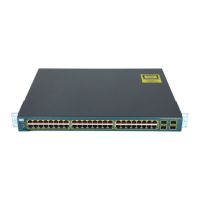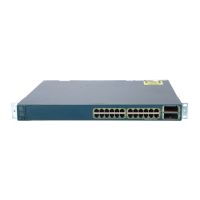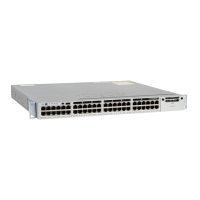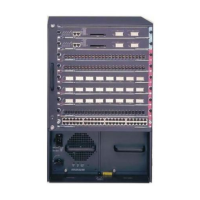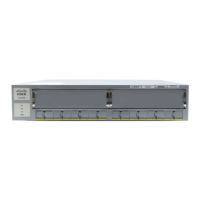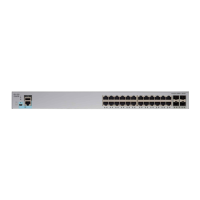32-46
Catalyst 3750 Switch Software Configuration Guide
78-16180-02
Chapter 32 Configuring QoS
Configuring Standard QoS
To delete an existing policy map, use the no policy-map policy-map-name global configuration
command. To delete an existing class map, use the no class class-map-name policy-map configuration
command. To return to the untrusted state, use the no trust policy-map configuration command. To
remove an assigned DSCP or IP precedence value, use the no set {ip dscp new-dscp | ip precedence
new-precedence} policy-map configuration command. To remove an existing policer, use the no police
rate-bps burst-byte [exceed-action {drop | policed-dscp-transmit}] policy-map configuration
command. To remove the policy map and port association, use the no service-policy input
policy-map-name interface configuration command.
This example shows how to create a policy map and attach it to an ingress port. In the configuration, the
IP standard ACL permits traffic from network 10.1.0.0. For traffic matching this classification, the DSCP
value in the incoming packet is trusted. If the matched traffic exceeds an average traffic rate of 48000
bps and a normal burst size of 8000 bytes, its DSCP is marked down (based on the policed-DSCP map)
and sent:
Switch(config)# access-list 1 permit 10.1.0.0 0.0.255.255
Switch(config)# class-map ipclass1
Switch(config-cmap)# match access-group 1
Switch(config-cmap)# exit
Switch(config)# policy-map flow1t
Switch(config-pmap)# class ipclass1
Switch(config-pmap-c)# trust dscp
Step 7
police rate-bps burst-byte [exceed-action
{drop | policed-dscp-transmit}]
Define a policer for the classified traffic.
By default, no policer is defined. For information on the number of
policers supported, see the “Standard QoS Configuration Guidelines”
section on page 32-31.
• For rate-bps, specify average traffic rate in bits per second (bps).
The range is 8000 to 1000000000.
• For burst-byte, specify the normal burst size in bytes. The range is
8000 to 1000000.
• (Optional) Specify the action to take when the rates are exceeded.
Use the exceed-action drop keywords to drop the packet. Use the
exceed-action policed-dscp-transmit keywords to mark down the
DSCP value (by using the policed-DSCP map) and send the packet.
For more information, see the “Configuring the Policed-DSCP
Map” section on page 32-51.
Step 8
exit Return to policy map configuration mode.
Step 9
exit Return to global configuration mode.
Step 10
interface interface-id Specify the port to attach to the policy map, and enter interface
configuration mode.
Valid interfaces include physical ports.
Step 11
service-policy input policy-map-name Specify the policy-map name, and apply it to an ingress port.
Only one policy map per ingress port is supported.
Step 12
end Return to privileged EXEC mode.
Step 13
show policy-map [policy-map-name [ class
class-map-name]]
Verify your entries.
Step 14
copy running-config startup-config (Optional) Save your entries in the configuration file.
Command Purpose

